The Rise of the Chief Revenue Officer
For any of us who have been in the sales and marketing world for more than ten years, you know that the title, “Chief Revenue Officer” is a fairly new one. It’s rise as an official title began to rear itself soon after The Great Recession around 2010. Is it just a novel little title to appease sales leaders who had no other place to go except to the CEO role? Or, is there a reason for its uprising?
To start, what is a Chief Revenue Officer (CRO)? Gartner defines it as:
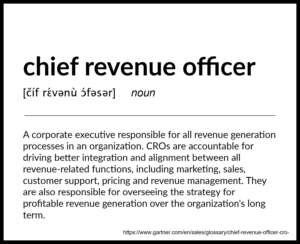
“a corporate executive responsible for all revenue generation processes in an organization. CROs are accountable for driving better integration and alignment between all revenue-related functions, including marketing, sales, customer support, pricing and revenue management. They are also responsible for overseeing the strategy for profitable revenue generation over the organization’s long term.”
The selling profession hasn’t changed all that much in the past 120 years. During the late 1800s, as the progressive era of the industrial revolution was just kicking into gear, it no longer made sense to simply engage with commission-only independent representatives, who traveled the country “representing” multiple products for multiple manufacturers. Companies like National Cash Register (NCR) and Burroughs Adding Machine began to hire their own salespeople, trained them themselves, provided salaries along with commissions, and guaranteed exclusive territories.
Sales was the primary vessel by which the message of the organization reached the potential end consumer. At the same time, a rise in advertising was taking shape – the function, the methodologies, and the investment. By 1907, quotes like “A salesman is no longer the essential factor, since advertising has become so generally popular and so prolific a source of orders.” appeared in Salesmanship Magazine. In 1912, Thomas Herbert Russell exclaimed that “Buyers know more nowadays” in his book, Salesmanship, talking to the concern that the proliferation of information available to buyers would potentially render the sales profession as meaningless.
A chasm developed. Advertising and marketing in one silo. Sales in another. Does that sound familiar? Do a search on “sales and marketing alignment” today, and the 46,000,000 results mostly speak to the challenge organizations face even today.
What was the solution in the early 1900s?
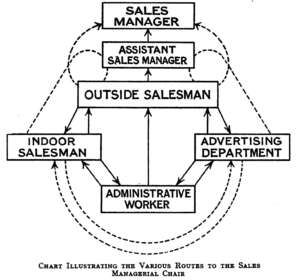
A typical sales org chart – this one from 1926 in “An Outline of Sales Management” (Knights)
By the 1920s, sales and advertising all rolled together under one leader, the “General Sales Manager”. One hundred years ago, the infancy of The Chief Revenue Officer was born.
Born from necessity, the need for one individual to oversee the language shared with the outside world required singular oversight. A typical organizational chart looked just like this one from the early 1920s. Advertising sat in the sales function, with a dotted line up to the “Sales Manager”, what we would call today a “Chief Sales Officer” or a “Senior Vice President of Sales”.
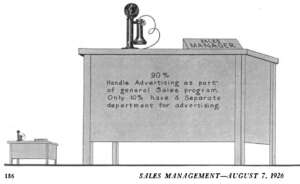
Statistic from 1926 on where advertising rolled up in a typical organization
Was this a common structure? Absolutely. As you see from the desk image from Sales Management Magazine in 1926, 90% of organizations rolled sales and advertising together, whereas only 10% did not.
For the next 80 years, the functional pendulum swung, where the roles rolled into one leader, separated out, and rolled together once again.
The Rise of the CRO
How has the sales profession changed requiring the rise of the Chief Revenue Officer position?
Is it that we’re in a technological revolution, where sales and marketing technology is filling every remaining crevice in each role? Nope. I would argue that the great technology revolution in sales and marketing started with Alexander Graham Bell’s first phone call in March of 1876 – leading to a revolution in sales and marketing outreach never to be matched. Ray Tomlinson’s first email in 1971 started a second revolution. Today is just a gap filler…
Is it the rise of information availability, and specifically self-service through eCommerce? Nope! Information abundance hasn’t made it easier on buyers, it’s actually made it harder. The sales professionals who understand that are the ones who continue to grow and thrive.
In my opinion, the rise of the CRO coincides with the rise of the “as a service” subscription economy. Software as a Service. Product as a Service. Everything as a Service. The initial deal is no longer the peak like it was when I started in sales.
In the 1990s, we sold software that was delivered on reels. Contracts took the form of a “perpetual license” – you bought the software with a large upfront payout, and owned the software forever. Each year, you paid a percentage of the initial purchase in the form of “annual maintenance”, which provided you with support and upgrades when available. The bulk of the revenue from a sale came at the time of purchase. For how long the customer stayed with the product and paid annual maintenance was less important. In other words, the sale itself was the peak!
In the “as a service” subscription economy, the contract is an early milestone in the customer lifecycle. the customer pays a lower up-front cost, essentially renting the software. Your success as a solution provider is in the long-term value of that new customer – how long do they stay, do they buy more, and are they willing to advocate? In other words, what you, as the provider, receive in year one is merely a blip on the journey to customer profitability. The requirement to sign the right customers with the right solutions at the right price has never been more important. It didn’t matter as much twenty years ago.
Couple that with the blowhorn that is social media, ratings and reviews proliferation, communities and the ease at which it is now possible to connect with peers, and client success has exploded. A client’s willingness to advocate positively is reliant on solution providers that set proper expectations from the beginning, and consistently MEET them throughout the customer’s stay! Not overpromise and underdeliver. Not even underpromise and overdeliver! Setting proper expectations, and consistently meeting them.
That is what has necessitated an intentional and always-on focus on the customer lifecycle, from the first touch to the tenth renewal. That has required the rise of someone to sit over sales, marketing, business development, partnerships and marketing to life and breathe, on a daily basis, that customer journey from end-to-end. Because, without it, expectation alignment undoubtedly degrades, finger-pointing grows, and customer lifetime value goes out the window.
(It’s also why the traditional way we’ve been taught to negotiate needs to change, too, but that’s a story for another day…)
The Chief Revenue Officer is an outgrowth to the “as a service” economy, and it’s here to stay.
Reach out if you want to discuss The Transparency Sale sales methodology, or really…anything else (sales kickoffs, workshops, keynotes, the economy, etc.)! Email info@toddcaponi.com or call 847-999-0420.
Sign up for the newsletter for more of my nonsense in your inbox every other week, with some sales history sprinkled on top…

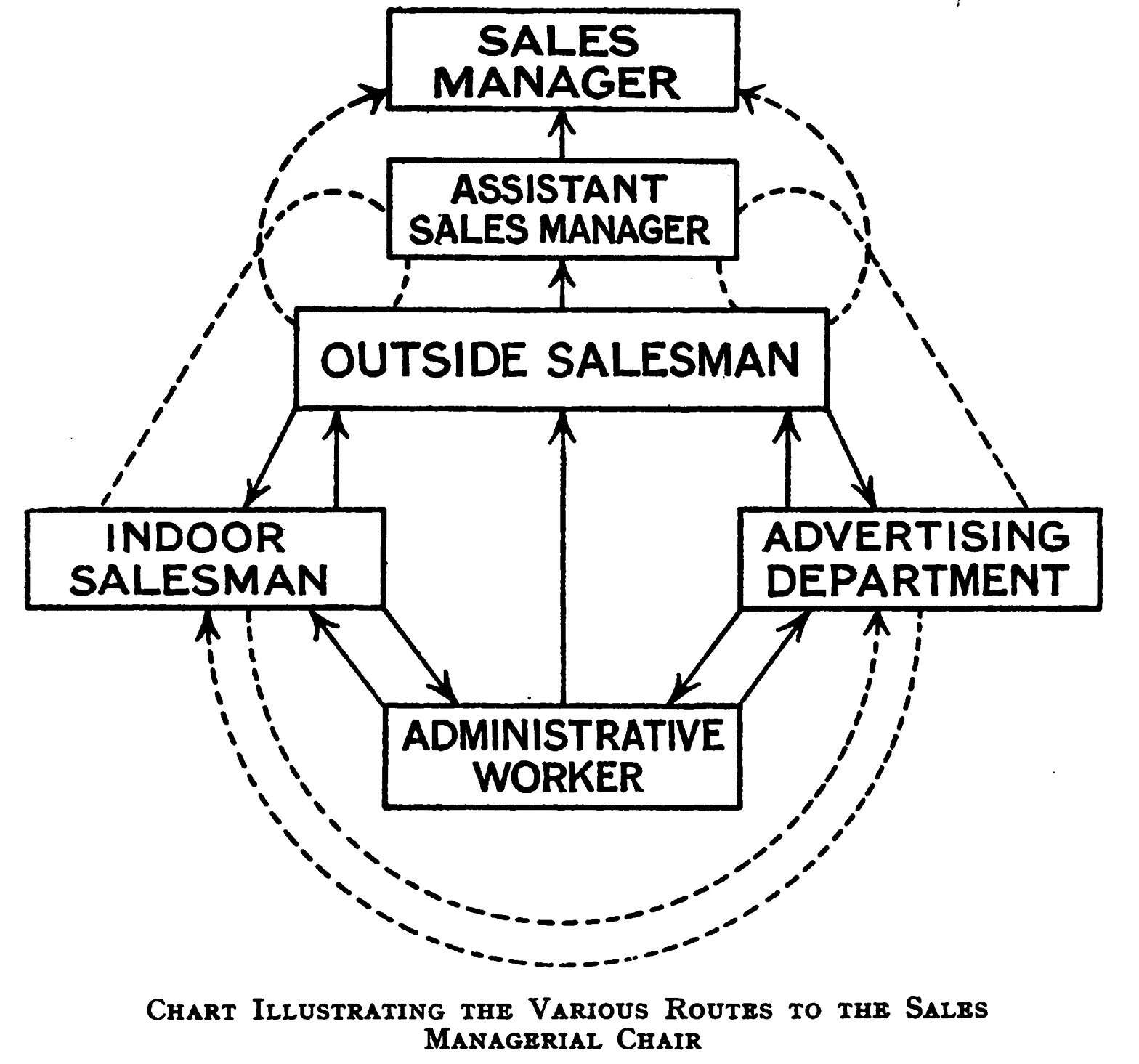



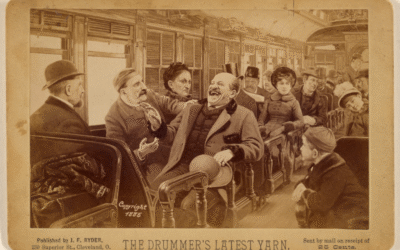
0 Comments